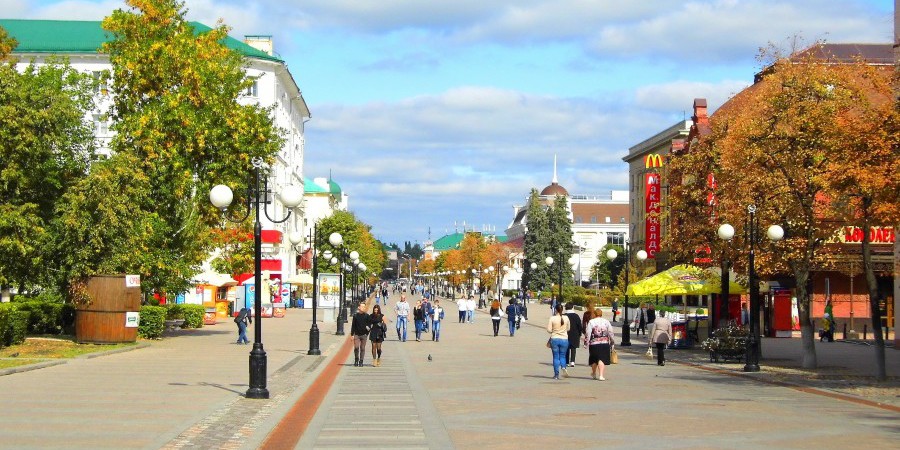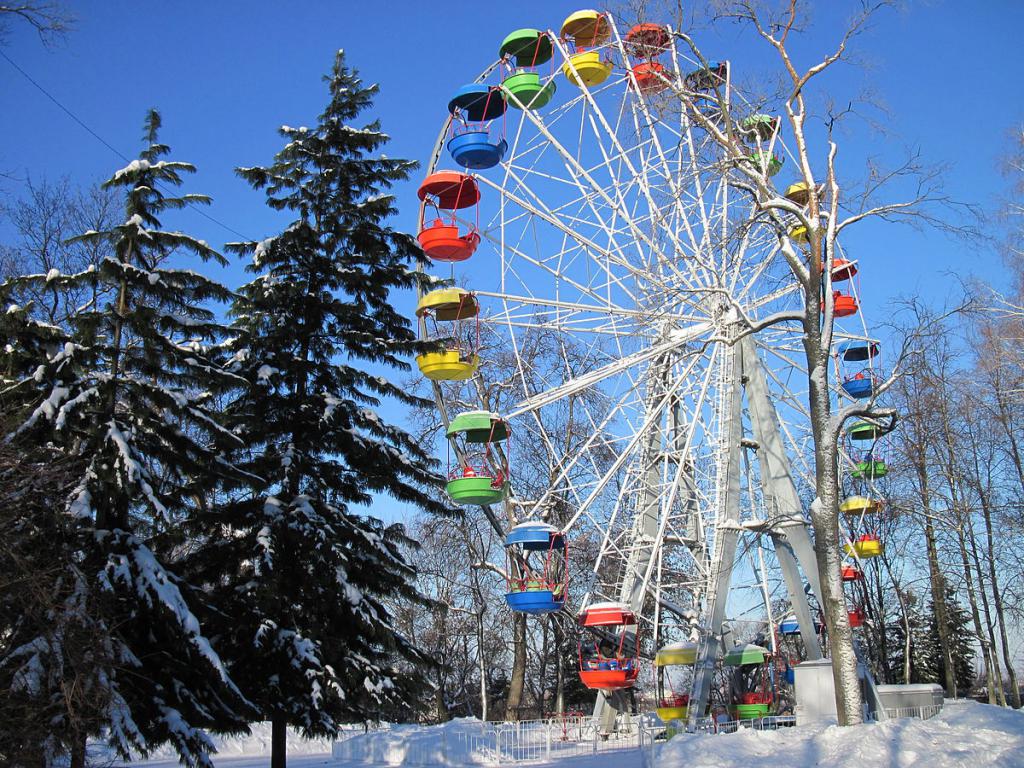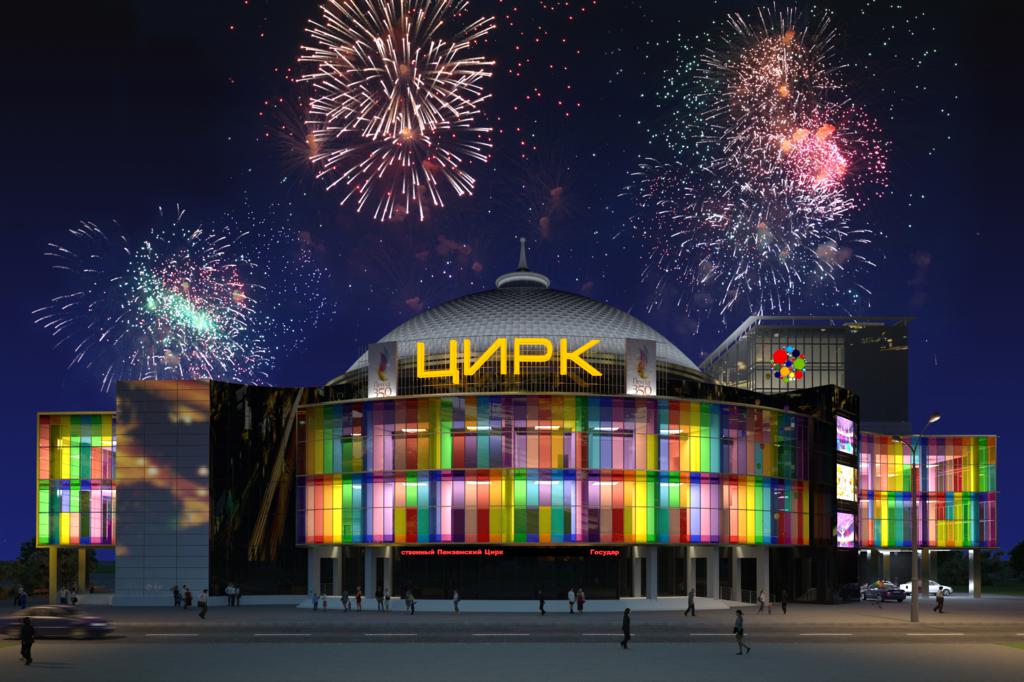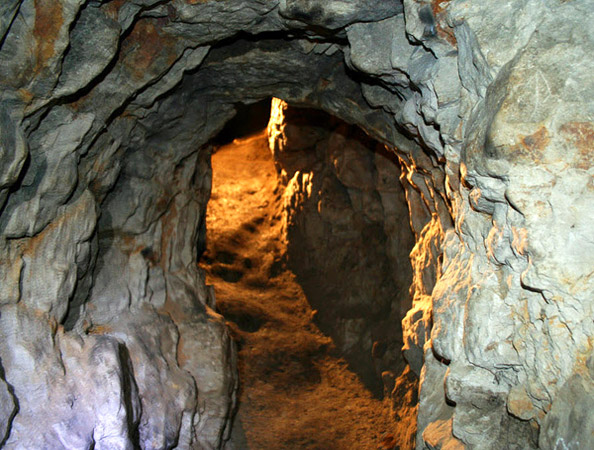Penza is a small but incredibly cozy town that combines provincial tranquility and a large number of cultural sites. The city is considered one of the greenest in the country. Tourists are fascinated by the beauty of old streets and impressive sights of Penza.
Moscow street
The main street of the city - Moskovskaya - is located in the historical center. She is one of the oldest in Penza. In addition, Moskovskaya Street is a pedestrian. Therefore, all guests should definitely take a walk in the local Arbat. Here you can find a large number of souvenirs and purchase portraits or paintings of artists.
Moscow street in itself is a landmark of Penza. Its history began in the middle of the seventeenth century, almost from the moment the town was founded. Over the past centuries, her appearance has changed a lot. It was once called Spasskaya, and later was renamed Bolshaya Posadskaya. It was only in the eighteenth century that a modern name was assigned to it, which was due to the fact that it was along this street that the road to Moscow passed. Initially, it was considered the shopping center of the city. Here, local merchants began to build the first two-story houses. Now on Moskovskaya Street there is a drama theater, shopping centers, banks and hotels. But its main attraction is the cuckoo clock and a large thermometer.

Also here is the Fountain Square. It hosts events during holidays and festivities. But on weekdays, it is no less crowded. In winter, the main Christmas tree is put on the square. Here is one of the main attractions of the city of Penza - the color and music fountain, which was installed back in 1977.
Museum of one painting
The museum of one painting is one of the most visited and famous sights of Penza. There is no second such place in Russia. People come to the museum in order to focus their attention on only one subject of art. Here you will not see large expositions and major exhibitions. Within the walls of the museum, only one picture is exhibited, and not any, but the most worthy.
The institution was opened in 1983. The museum hall is designed for only 40 people. The session lasts for 45 minutes. During this time, guests are invited to watch a movie about the creation of a masterpiece and its author, and at the end they offer to see the picture itself.
The idea of opening such an unusual museum belonged to Myasnikov G.V. Over the years the institution has existed, the works of Kustodiev, Levitan, Shishkin, Repin, Savrasov, Vodkin, Surikov and others were exhibited in its walls.
Park them. Belinsky
The attractions of Penza can safely be attributed to the Belinsky Park, which is one of the oldest in the country. Its history began back in 1821, when Emperor Alexander the First issued a decree on urban improvement. During this period, the process of ennoblement of provincial cities began. Each had its own garden. The governor of Penza invited to set up the park of the German gardener Ernst Magzig. Construction lasted until 1836. During its existence, the park has changed many names. In 1911, they decided to rename the garden in honor of the 100th anniversary of Belinsky. The park has a gate with a bas-relief of the famous critic. The formation of the garden was based on the style of natural oak groves. It is very nice to relax in any weather. In a couple come not only guests of the city, but also its residents who walk here with children.

Some trees in the garden are already 300 years old. In the territory of the modern park there are cafes, attractions and dance floors. And by cable car from here you can quickly get to the central square of the city. For lovers of hiking, there is a health trail. Also in the park there are two springs.
Penza Circus
The circus can be safely called the main attraction of Penza. The fact is that Penza is the birthplace of the Russian circus. The first such stationary institution appeared in this city in 1873. A little later, the circus appeared in Saratov. The first views were very different from modern ones. They were held on the ice of the Sura River. Straw was laid on the ice surface, and poles were placed inside the ice, a tarp was pulled on top. It turned out to be a pretty good arena. In 1906, the circus already had its own wooden building, which was destroyed during the Civil War. Subsequently, the troupe worked in various temporary buildings. Subsequently, a wooden big top appeared. There were always so many visitors in the circus that in 1941 local authorities decided to build a new building. But all plans collapsed due to the war. Until the 50s, the troupe gave performances in different places of the city. The career of many famous artists began in the Penza Circus. For example, Teresa Durova and Oleg Popov worked here for some time.

And only in 1965 a new circus appeared in the city, which immediately became a cultural attraction of Penza. The building was so large that it was able to immediately receive 1,400 spectators. The local troupe toured around the world. In addition, the circus building became a real concert venue of the city, which was performed by Valery Leontiev, Sofia Rotaru and Alla Pugacheva. In 2002, the circus was named after Teresa Durova. Currently, the building is being reconstructed, it has been partially dismantled and a more spacious and modern building with a transformer hall is being built on its basis.
Church of the Transfiguration
Church of the Transfiguration of the Lord is a historical landmark of Penza. This is the oldest building that has survived in the city. Experts say that the history of the building began in the seventeenth century. In 1689, a man’s monastery was erected on the same spot. But the church itself was built later, in 1735-1750. The new temple became part of the monastery.
The church had its own peculiarity, it consisted of two parts: lower and upper. The latter was not heated. Therefore, it was held in the warm season. The lower temple, on the contrary, was very warm, so it worked in the winter. In 1794, due to the growth of the city, the church was moved beyond its borders. In 1931 the temple was closed. In the further building there was an archive. And only in 1993 the church was reopened.
Tarkhan
Penza and the Penza region are rich in attractions. One of the most interesting places is the Tarkhany Museum-Reserve, located 100 kilometers from the city. The Russian poet M. Yu. Lermontov grew up in this estate. A unique historical and cultural monument is located in the village of Lermontovo. The museum-reserve is included in the lists of especially valuable cultural monuments. On its vast territory there are quite a few objects that are associated with the poet's childhood. In the center of the estate is the manor house in which Lermontov was born, his belongings and family relics are stored here . The complex includes the Temple of Mary of Egypt, a hut for people, a monument to the poet, a place for children's entertainment, a distant garden, a windmill, three ponds, a green theater, a park with an oak grove, the Church of St. Michael the Archangel.

Currently, the museum-reserve is a collection of original and rare household items of landowners from the 17-18th centuries. Especially this place is dear to the admirers of the poet's talent. The museum offers guided tours, folklore festivals, poetry evenings, folk craft workshops and other events.
Trinity-Skanovsky Monastery
The real gem of the sights of Penza and the Penza region is the Trinity-Scanovskii Convent, located in the village of Skanovo. The history of the architectural complex began in the early seventeenth century. Unfortunately, during the fire, all the papers related to the construction burned. After that, a wooden belfry and a church were rebuilt, which in 1795 were replaced by stone buildings. The complex includes a five-domed cathedral church with painted exterior walls. Currently, in the center of the monastery is the Trinity Cathedral. Also on the territory you can see the church of St. Nicholas the Wonderworker and the Baptist Church. All buildings of the complex are designed in approximately the same architectural style. Before the revolution, the monastery was male. And after 60 years of Orthodox oblivion, a women's institution was established. The main shrine of the monastery is the icon of the Mother of God, which is listed as miraculous.
Cave complex
Of the attractions of Penza and the region is very interesting cave three-level complex. On its territory there are two healing springs. The cave monastery was founded by Arseny II, who was the first to retire to his cell underground. Later, several more people joined him. Together, a stone church and a chapel were built. The length of the underground passages was 2.5 kilometers. According to legend, at the lowest, seventh level was a spring with clean water. In the thirties, the chapel and the temple were completely destroyed, and the cave itself was dismantled in bricks for household needs.

This caused the collapse of the lower tiers. Now cave labyrinths are only 600 meters long and are divided into three tiers. The height of the central corridors and walkways was two meters. The last decade has been the strengthening and restoration work. However, such a large cave object remains unexplored to this day. From the entrance to the dungeons, a long staircase leads to the mountain, which had previously been used to climb to the church. Now you can go upstairs and admire the panorama of the surroundings.
Museum of Glass and Crystal
Description of Penza sights would be incomplete if we do not recall the Museum of Crystal and Glass in the town of Nikolsk, which is even called the "crystal heart of the Penza Region." At one time, the museum was opened on the basis of a glass factory. It was based on a collection of factory works. Over the years, the exposition has replenished with products from English, French, Bohemian, Polish crystal.
The plant was opened by decree of Catherine II. By order of the empress, the best samples of foreign products for copying were brought to him. The owner of the village N. Bakhmetev brought the plant to the level of one of the best in Russia. The following generations improved and expanded production. In 1923, the plant was nationalized. But his collection of glass gradually increased, and then was placed in a separate building. Now everyone can visit the exhibition halls and appreciate the work of the best masters.
Museum of Local Lore
Among the attractions of the city of Penza, it is worth paying attention to the museum of local lore. It is located within the walls of a two-story old red brick mansion. The museum can be safely called a real storehouse of the history of the city. Its halls host 125 thousand exhibits. All of them are an invaluable legacy of previous generations. The museum currently does not have a permanent exhibition, so the exhibits change periodically. Its rich collection is filled with unique things and historical values from different times. The museum acquired the status of local history in 1924. Even during the war, he did not stop his work. In the future, his exposition was significantly enriched due to the active work of museum workers.
Traffic light tree
The city has something to see. The sights of Penza are so diverse that every tourist can find something interesting for himself. In the city center, at the crossroads of Oktyabrskaya and Suvorov Streets, you can see a very unusual art object - Traffic Light Tree.
A modern attraction appeared in the city recently, in 2011. The idea of creation came after all the old traffic lights were removed in Penza, and new ones were put in their place. Unnecessary specimens combined into a single composition. The initiator of the installation of an unusual tree was the mayor of the city. The prototype of the composition is a similar tree in London, which is large. Initially, the art object was planned to be included only on holidays and weekends. But everyone liked the wonderful tree so much that now it lights up every day at dusk. An interesting fact is that nowhere else in Russia is there any more such an object.
Defensive shaft
The sights of Penza include the memorial "Defensive Wall", located in the historical center. The complex is complemented by a sculpture called "First Settler". The memorial is set in place of a wooden defensive fortress. Unfortunately, nothing was left of it, so only the monument recalls the heroic past of the region.
Historians claim that the Penza fortress was built to protect the southern borders of the Russian Empire from nomads. Plots of land shafts can still be found in the city in some places, but the buildings of those times were not preserved at all. All those buildings, which are a constant addition to the fortress, were built not so long ago with a hint of antiquity.
Zolotarevskoe settlement
One of the interesting sights of Penza (photos of some of them are given in the article) and its area is the Zolotarevskoe settlement, which is located near the village of Zolotarevka. As early as 1882, archaeologists found an ancient settlement dating from the 3-4th century. As a result of excavations that have been going on for several decades, it was possible to reach a large settlement, whose area is 16 hectares. Historians believe that the settlement was on the route to Kiev from Bulgar. For many years it served as a border zone. Fenced on all sides by high ramparts and deep moats, as well as forests, the city has been an impregnable fortress for many centuries. Excavation materials indicate that from the eighth to the tenth century, Mordvinian culture prevailed in the settlement. Perhaps the settlement would continue to exist safely, but during the battle the Mongol during the battle the fortress was destroyed. Numerous body remains and Mongolian weapons were found under small layers of greenery. After a terrible battle, people no longer settled in the area. And the fortress itself was never touched until our times.
Excavations are still ongoing, during which something new appears. Zolotarevskoe settlement is considered a unique historical medieval monument.